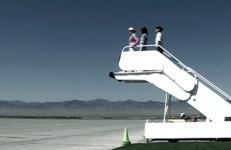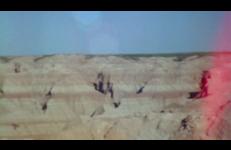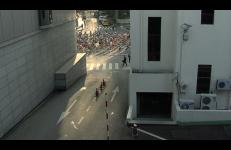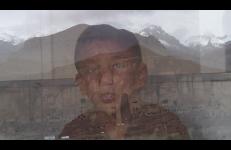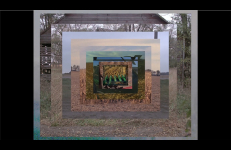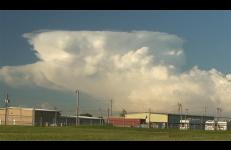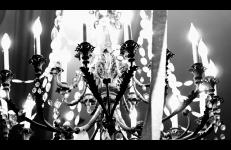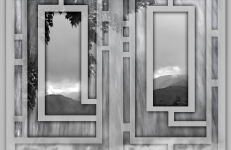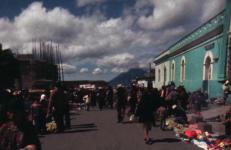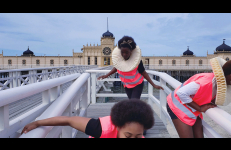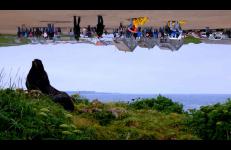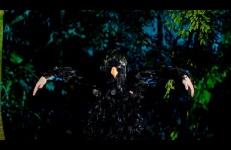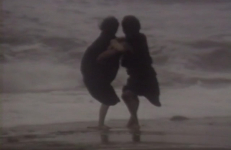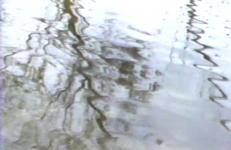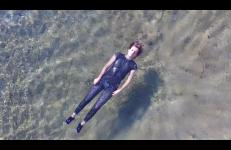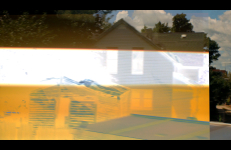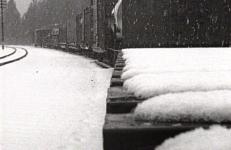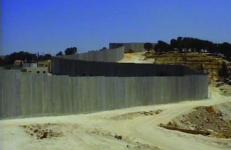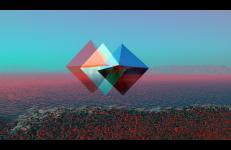They just flew in from New York, and boy, are their arms tired... Out in the Nevada desert, against the windblown backdrop of Air Force bomber training sites, artists Hajoe Moderegger and Franziska Lamprecht — better known as eteam — gathered testimonials of stranded passengers, crew members, and local residents to recall an episode in the lost annals of American aviation: the 2006 "unscheduled layover" at International Airport Montello (IAM). Truth in Transit reaches beyond simple documentation.
Landscape
“Trypps #7 (Badlands) charts, through an intimate long-take, a young woman's LSD trip in the Badlands National Park, before descending into a psychedelic, formal abstraction of the expansive desert landscape. Concerned with notions of the romantic sublime, phenomenological experience, and secular spiritualism, the work continues Russell's unique investigation into the possibilities of cinema as a site for transcendence.”
-- Michael Green, Museum of Contemporary Art, Chicago
Originating from personal affection toward Seoul, Twelve Scenes portrays the spectacles in daily life by juxtaposing urban space in a twelve month sequence. As the individual particles in a kaleidoscope create splendid illusions by being reflected on a mirror, Twelve Scenes shows our individual life, seemingly separated by time and space, actually composes the scenery in the kaleidoscope of Seoul. Twelve Scenes represents a 'moment for self-reflection' or 'small, but precious enlightenment on life'.
Out of the mouths of rural boys, finding the incomparable Mulla Nasrudin in Afghanistan.
A hug/punch eulogy for all things impossible now. Vague Images is a sketch book of images and sounds from the year wrapped around a trip out to Loomis, South Dakota to find the abandoned farm where my grandfather grew up. At the same time the film is a travelogue of my frustrations and understandings of gay sexuality. The two are connected.
One of my weather diary series out in Oklahoma. The tone is wistful, the surroundings wispy (with some puffs of pungency). The TV is on and the porcelain is smeared with some residue atrocity from a previous passion. But all is well as emptiness persists beyond the four walls of this prairie mausoleum.
"A group of students and teachers gather in an historical mansion in the woods of West Virginia for a week-long retreat in spoken Latin. I observe and I participate while navigating the errata with my camera."
— Sky Hopinka
Both Vermont Landscape and Pond Life followed two opera collaborations with composer Steve Reich. The operas were a new genre called a Theater of Ideas, which said a great deal about the world cultures in which we all live. In contrast, these two small works are quiet, with no words.
A cross-generational binding of three filmmakers seeking alternative possibilities to the power structures they are inherently part of. Each woman extends her reach to a subject she is outside of. Vever grew out of the abandoned film projects of Maya Deren and Barbara Hammer. Shot at the furthest point of a motorcycle trip Hammer took to Guatemala in 1975, and laced through with Deren’s reflections of failure, encounter and initiation in 1950s Haiti.
A vever is a symbolic drawing used in Haitian Voodoo to invoke Loa, or god.
Filmed entirely in Sweden, VIEWFINDER is a surreal sound-film that entangles gestures of place, belonging, and monument. Informed by archival research, oral history, and folk stories, the film focuses on Black immigrants who have recently migrated to Sweden. These performers enact dance-like choreographies in critical sites across the coastal town of Varberg, generated in response to an absence of Black life found in the municipal archives.
An Unangam Tunuu elder describes cliffs and summits, drifting birds, and deserted shores. A group of students and teachers play and invent games revitalizing their language. A visitor wanders in a quixotic chronicling of earthly and supernal terrain. These visions offer glimpses of an island in the center of the Bering Sea.
A documentary fiction inspired on the first accounts of the natural and ethnographic explorations in America by colonizers, missionaries, and scientists. Shot in the Tropical Greenhouse of Lille, France, the film uses both the architecture and the plants of this enclosed botanic garden as narrative supports for an exploratory journey. Led by the voice-over of an explorer, the film explores the notion of exoticism, evokes the violent origins of the so-called "New World" and the endurance of the imagery they engendered.
Adapted from their performance work Fur Seal (1977), this video is the first and only outdoor work Eiko & Koma created for video. The piece was filmed at Pt. Reyes, California in November 1983. Eiko & Koma were very cold because of the water and wind–so were the film crew! Eiko edited the piece with the help of Jeff Bush.
This work was originally designed with no sound and was 19 minutes long but in this shorter version, Eiko added the sound of sea waves.
A rural sunset at the edge of the water in WandaWega Waters. The natural rhythmic movement of the water’s surface becomes a highly colored abstraction in motion, a meditation on the intersection of nature and technology.
Every country employs specific techniques for disguising its soldiers, every army has developed its own camouflage uniforms. Croatia is one of the few countries in the world that uses a digitized shape of its own territory in its camouflage military design. Why? The question is not meant to be answered by human reason. It does not relate to the perception of human eyes. Night vision cameras, binoculars, heat detectors and drones have their own ways of seeing the world.
What Rules The Invisible is a short film that upends archival travelog footage shot in Hong Kong. Spanning reappropriated amateur footage across the 20th century, the sojourner’s gaze—distanced, distorted and even voyeuristic—shows tropes and patterns. The same shots repeat across decades, from landscape to cityscape to street scenes. Sometimes the footage reveals more about the traveler himself, such as a sequence where the camera curiously tracks the hips and bare legs of women wearing cheongsam crossing a busy intersection.
In this video, drawing from Bob Dylan's song Just Like Tom Thumb's Blues, layers of experiences circling loss and longing are overlaid between images of landscapes and movement. In the song, a stranger's listlessness and exhaustion are woven through and around Juarez, Mexico, and so too are these stories woven around original discontent and uncertainty as they move through an uneasy negotiation with the strangeness of the American pioneer spirit.
Commissioned by Brianna Matzke for The Response Project, 2018.
White Sands is an experiential film installation on the visible and invisible manifestations of the nuclear industry on the land, air, water and people of New Mexico.
Cinematography: Liz Cash
Hand Film Printing: Sylvain Chaussee, Niagara Lab
Sound design: Stephen Vitiello
White Sands is available through Video Data Bank as a three-channel composite.
The secret history of hobo and railworker graffiti. Shot on freight trips across the western US over a period of 16 years, Who is Bozo Texino? chronicles the search for the source of a ubiquitous rail graffiti--a simple sketch of a character with an infinity-shaped hat and the scrawled moniker, "Bozo Texino"--a drawing seen on railcars for over 80 years.
Two video letters made to communicate the artists longing for her friends, and produced with the same images from her daily life in Israel. The first is addressed to Jacqueline, the artist’s Swiss friend in Zurich, and the second to Abla, her Palestinian friend in Nablus.
This title is only available on Radical Closure.
The Greek island of Syros is visited by a series of unexpected guests. Immutable forms, outside of time, aloof observants to our human condition.




